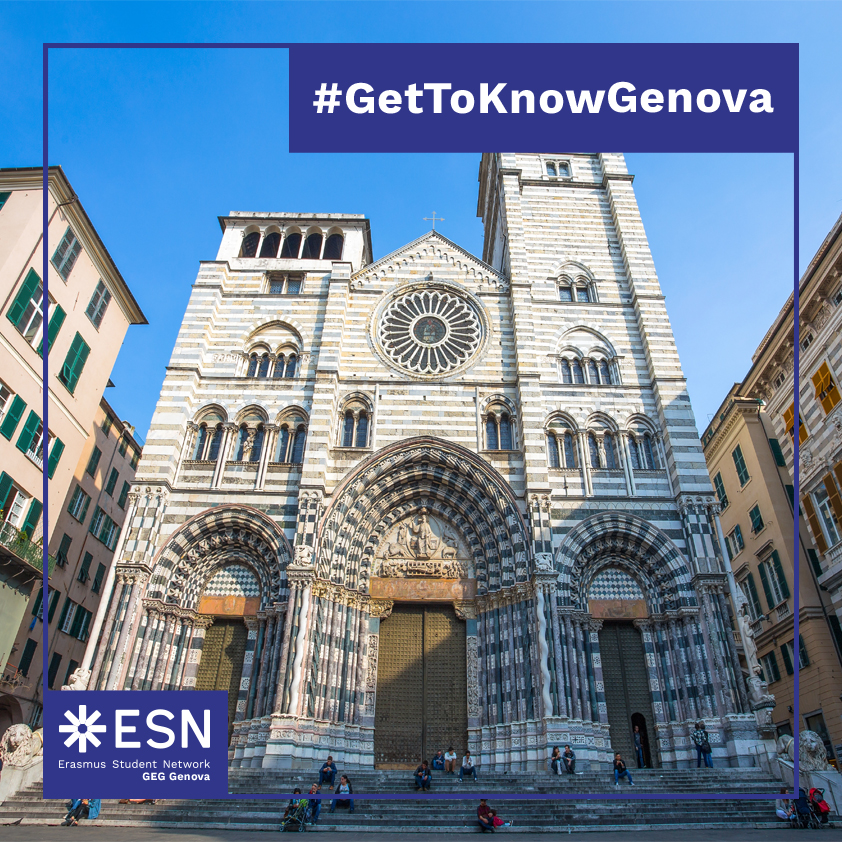
La chiesa più importante di Genova è la cattedrale di San Lorenzo. Attorno al duomo dei genovesi e alle raffigurazioni in facciata circolano storie curiose e leggende affascinanti.
Eretta intorno all’anno 1098 su una precedente basilica del V - VI secolo e ampliata nei secoli in forme solenni e preziose, la cattedrale intitolata a San Lorenzo Martire custodisce le ceneri del patrono della città San Giovanni Battista, giunte a Genova alla fine della Prima Crociata.
La basilica di San Lorenzo diventa cattedrale a partire dal IX secolo, sostituendo la basilica dei Dodici Apostoli, dedicata nel VI secolo a San Siro, vescovo di Genova, che a quei tempi si trovava al di fuori dell’antico nucleo della città.
Grazie al trasferimento della cattedrale e alla costruzione delle mura, la zona di San Lorenzo diventa il cuore della città che cresce e cambia: in una città senza piazze, il sagrato di San Lorenzo offre per tutto il medioevo un palcoscenico fondamentale per la vita politica e civile.
Papa Gelasio I la consacra a cattedrale nel 1118, e prende avvio la sua ricostruzione in forma di chiesa romanica, con fondi provenienti da tasse comunali e da imprese militari come le Crociate. Dal 1133 la chiesa ottiene il rango arcivescovile.
Dopo l’incendio del 1296, l’edificio viene in parte restaurato e in parte ricostruito nelle forme dell’architettura gotica: tra il 1307 e il 1312 viene completata la maestosa facciata a bande bianche e nere, si affresca la confrofacciata e vengono rifatti i colonnati interni, con nuovi capitelli e l'aggiunta dei falsi matronei; come succede spesso a Genova, si preservano le strutture romaniche ancora in buono stato.
Tra il XIV e il XV secolo la cattedrale si arricchisce di nuovi altari e cappelle, fra cui la splendida cappella che conserva le ceneri di San Giovanni Battista, vero capolavoro di arte del Quattrocento, nella navata sinistra.
Nell’anno 1455 viene costruita la piccola loggia sulla torre nord-est, in facciata, cui si aggiunge nel 1522 quella opposta, nelle forme tipiche dell’architettura manierista.
A metà Cinquecento, su ordine delle magistrature cittadine, l’architetto perugino Galeazzo Alessi riprogetta l’intero edificio, riuscendo però a far ricostruire solo copertura delle navate, pavimento, cupola e zona absidale. Ma per vedere finalmente conclusa l’opera del duomo occorrerà attendere il Seicento, con il tripudio di stucchi dorati dell’abside e degli affreschi tardo manieristi delle “Storie di San Lorenzo” di Lazzaro Tavarone.
Un restauro di fine Ottocento ha valorizzato le parti medievali che caratterizzano l’aspetto attuale della cattedrale.
Una curiosità: a imperitura memoria contro gli orrori della guerra, all’interno della cattedrale, nella navata destra, è presente la copia esatta di un ordigno inesploso. La granata fu sparata nel 1941 dalla flotta britannica nel corso di uno dei peggiori attacchi sferrati contro Genova durante la seconda guerra mondiale.
ENGLISH:
The most important church in Genoa is the Cattedrale di San Lorenzo. The Genoese cathedral and the artistic representations on its walls gave rise to many legends and curiosities.
It was built around the year 1098 to support and then replce a sailica, which dated back to the 5th or the 6th century, and was later enlarged with solemn and precious forms. The cathedral is dedicated to San Lorenzo Martire and guards the ashes of the patron saint of the city San Giovanni Battista, brought to Genoa at the end of the First Crusade.
The basilica of San Lorenzo became a cathedral in the 9th century, replacing the basilica of the Twelve Apostoles, dedicated to the bishop of Genoa San Siro in the 6th century. In those times the building was located outside the city walls.
Thanks to the relocation of the cathedral and the construction of the walls, the area of San Lorenzo became the heart of the city, which grew and changed: in a city without squares, the parvis of San lorenzo offered a fundamental stage for the social and political life during the Middle Ages.
Papa Gelasio I consacrated the cathedral in 1118, when the reconstruction of the church in Romanesque style started thanks to the funds coming from city taxes, military ventures and Crusades. In 1133 the cathedral became the seat of the archibishop of Genoa.
In 1296 there was a fire and after the incident the building was partially restored, the other part was reconstructed in Gothic style: between 1307 and 1312 the majestic facade with white and black stripes was completed, the counter facade was frescoed and the inner colonnades where restyled with new capitals and the addition of false matronea; as it often happened in Genoa, the well preserved Romanesque structures were maintained. Between the 14th and the 15th century the cathedral was enriched with new altars and chapels, among them there is the splendid chapel in the left aisle, in which are guarded the ashes of San Giovanni Battista, a true masterpiece of the 15th century art.
Meanwhile, in 1455 the small loggia in the north-east tower of the facade was built, and in 1522 the opposite one was added, folloqing the rules and shapes of Mannerist architecture.
In the middle of the 16th century, on the instructions of the city judiciaries, the architect Galeazzo Alessi from Perugia redesigned the whole building, only succeeding in the reconstruction of the roofing of the aisles, the floors, the dome and the apse area. To finally be able to see the completed cathedral i twill be necessary to wait until the 17th century, with a triumph of gilded stucco which decorated the pase and the late Mannerist frescoes which represented the “Stories of Saint Lawrence” by Lazzaro Tavarone.
A restoration at the end of the 19th century enhanced the medieval parts that currently characterized the aspect of the cathedral.
A curiosity: to the undying memory of the horrors of war, inside the cathedral, in the right aisle, it has been preserved the exact copy of an unexploded bomb. The grenade was shot in 1941 by the British Royal Fleet during one of the worst attacks against the city of Genoa during the Second World war.





Follow us